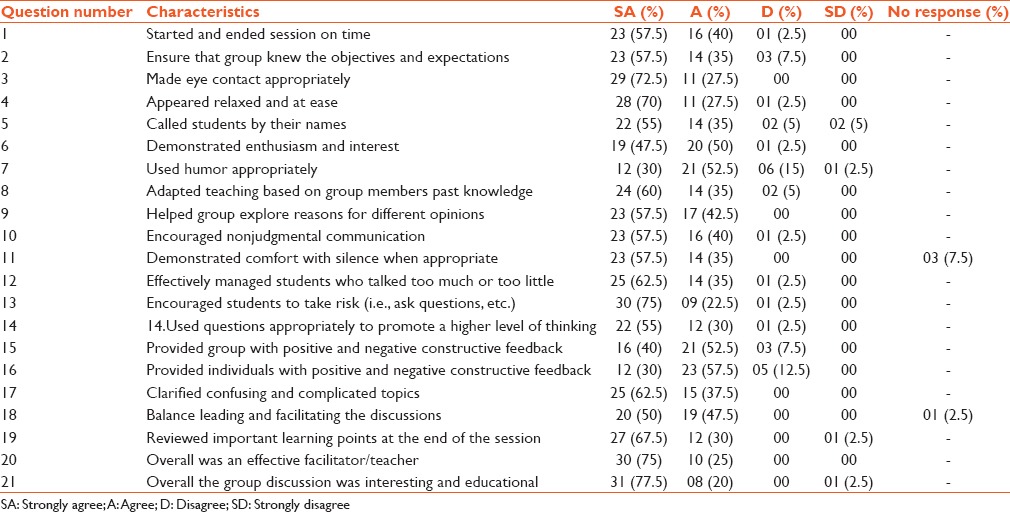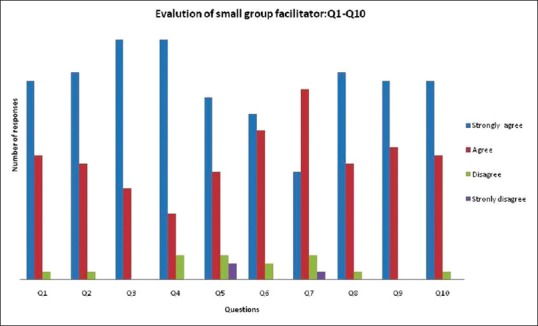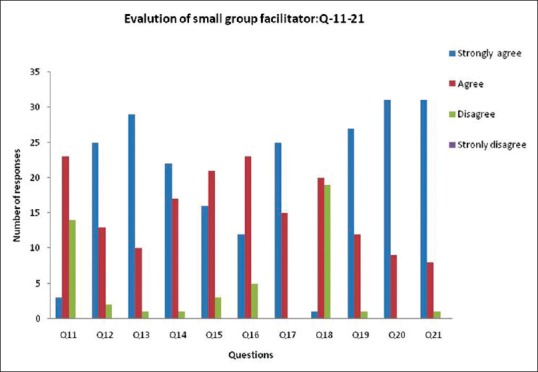Abstract
Context:
Various alternative methods are being used in many medical colleges to reinforce didactic lectures in physiology. Small group teaching can take on a variety of different tasks such as problem-solving, role play, discussions, brainstorming, and debate. Research has demonstrated that group discussion promotes greater synthesis and retention of materials.
Aims:
The aims of this study were to adopt a problem-solving approach by relating basic sciences with the clinical scenario through self-learning. To develop soft skills, to understand principles of group dynamics, and adopt a new teaching learning methodology.
Subjects and Methods:
Experimental study design was conducted in Phase I 1st year medical students of 2014–2015 batch (n = 120). On the day of the session, the students were grouped into small groups (15 each). The session started with the facilitator starting off the discussion. Feedback forms from five students in each group was taken (n = 40). A five point Likert scale was used ranging from strongly agree to strongly disagree. Data were analyzed using IBM SPSS Statistics for Windows, Version 21.0. Armonk, NY: IBM Corp.
Results:
Our results show that 70% of the students opined that small group discussion were interactive, friendly, innovative, built interaction between teacher and student. Small group discussion increased their thought process and helped them in better communication.
Conclusions:
The small group discussion was interactive, friendly, and bridged the gap between the teacher and student. The student's communication skills are also improved. In conclusion, small group discussion is more effective than the traditional teaching methods.
Keywords: Medical education, problem-based learning, self-directed learning, small group teaching
INTRODUCTION
The curriculum followed in medical colleges of India is overloaded with the large amount of knowledge pertaining to basic science and clinical disciplines. Compartmentalization among departments, lack of integration, poor coordination between basic sciences and clinical subjects, adherence to traditional didactic pedagogical methods of instruction could be possible areas for improvement in the existing curriculum.[1] Medical Council of India, in the recent Vision 2015 document, recommended foundation courses to orient students to national health scenarios, learning skills and communication, vertical and horizontal integration to bridge the gap between theory and practical and emphasis on early clinical exposure.[2]
Conventionally, teaching of undergraduate students is done with didactic lectures, practical, tutorial, and clinics. These are more of passive teaching learning methods, development of problem-solving or reasoning skills in students is lacking. There is hardly any involvement of students in the teaching learning process.[3] Small group teaching has been the highlight of medical education over past many years. Small group teaching can take on a variety of different tasks such as problem-solving, role play, discussions, brain storming, and debate.[4] Research has demonstrated that group discussion promotes greater synthesis and retention of materials.[5] Our college that is recognized by medical council of India also planned to introduce a new teaching learning method in the form of small group teaching.
This study was undertaken with the aims of - to motivate students to adopt a problem-solving approach by relating basic sciences with clinical scenario and to apply concepts of theory to clinical conditions through self-learning; and to develop soft skills such as communication skills and to understand principles of group dynamics. Another aim was to motivate peer group to adopt a new teaching learning methodology.
SUBJECTS AND METHODS
This study was conducted in the Department of Physiology, Chennai Medical College Hospital and Research Center, Trichy, Tamil Nadu. The participants for this study were Phase I Bachelors of Medicine Bachelors of Surgery of 2014–2015 batch (n = 120). The students and the teachers were informed, and the case to be discussed was given to the students 2 days before the session. The cases were prepared from the topic, which was taken for the students as a didactic lecture, a week before the session.
On the day of the session, the students were grouped into small groups of 15 students each. A facilitator was provided for each group. The session started with the facilitator starting from the discussion. The student interacted with each other on the case scenario to be discussed. The facilitator only facilitated the learning process and controlled the discussion. Feedback forms from five students in each group was taken (n = 40). A five point Likert scale was used ranging from strongly agree to strongly disagree [Table 1]. The questionnaire was validated by Medical Education Unit Faculty of Sri Ramachandra Medical College, Chennai.
Table 1.
Student response (in numbers and percentage) to different questions on Likert scale (Q 1–21)

RESULTS
Table 1 shows that 31 students (77.5%) strongly agreed for question no. 20 and 21; 29 students (72.5%) strongly agreed for question no. 13; 27 students (67.5%) strongly agreed for question no. 19; 25 students (62.5%) for question no. 12 and 17. Totally, 23 students (57.5%) agreed for question no. 11 and 16; 20 students (50%) agreed for question no. 15 and 18; 17 students (42.5%) for question no. 17.19 students (47.5%) disagreed for question no. 18 and 19; 14 students (35%) disagreed for question no. 14; no student strongly disagreed for any question.
Of the 40 feedback forms got from the students, 90% said that they understood the topic very well. Seventy percent of the students opined that small group discussion was interactive, friendly, innovative, built interaction between teacher and student. They also felt that small group discussion increased their thought process and helped them in better communication. Thirty percent said that the case scenarios should be given a week ahead. Few students want this session to be frequently conducted and for difficult topics [Figures 1 and 2].
Figure 1.

Student response (in numbers) to the questions from 1-10
Figure 2.

Student response (in numbers) to the questions from 11-21
DISCUSSION
This study showed that small group discussion provided opportunities for students to speak in front of others and to receive feedback from teachers and peers. Sharmila SR et al[6] reported that small groups can be an effective learning situation in which students learn from their teachers and interaction with each other. Our findings were concordant with the previous study report. Group discussion increased active participation of students as it was observed in our study; it makes more student friendly than traditional teaching methods. It also helps self-directed learning and to exchange ideas. Similar findings were reported in the previous literature.[7,8]
CONCLUSION
The present teaching learning intervention was an attempt toward the introduction of self-directed learning. The small group discussion was interactive, friendly, and bridged the gap between the teacher and student. The student's communication skills are also improved. We, therefore, conclude that small group discussion is more effective than the traditional teaching methods.
LIMITATIONS OF THE STUDY
The questions were not given well ahead for the students to prepare. It needs more time and space, more facilitators to cover the topic. It is difficult to convince some faculty members in the implementation of new teaching learning method.
Acknowledgments
Authors thank the faculty of the Department of Physiology CMCH and RC for helping in conducting the small group discussion. We thank Mr. Ismail, Research Cell, CMCH, and RC for helping in the analysis of the data. The authors also thank the students who participated in this study and gave a fair feedback on the facilitators.
Financial support and sponsorship
Nil.
Conflicts of interest
There are no conflicts of interest.
REFERENCES
- 1.Sood R, Adkoli BV. Medical education in India – Problems and prospectus. J Indian Acad Clin Med. 2000;1:210–2. [Google Scholar]
- 2.Medical Council of India. Vision. 2015. [Last accessed on 2012 Jan 07]. Available from: http://www.mciindia.org/tools/announcement/MCI-booklet.pdf .
- 3.Gade S, Chari S. Case-based learning in endocrine physiology: An approach toward self-directed learning and the development of soft skills in medical students. Adv Physiol Educ. 2013;37:356–60. doi: 10.1152/advan.00076.2012. [DOI] [PubMed] [Google Scholar]
- 4.An Environmental Scan of Best Practices in Public Health Undergraduate Medical Education. Report 5: Strength, Weakness and Applicability of Teaching Methods. 2009 Mar [Google Scholar]
- 5.Davis B. San Fransisco, CA: Jossey-Bass Publishers; 1993. Tools for Teaching. [Google Scholar]
- 6.Sharmila SR, Mungal SU, More SR. Developing competencies of medical students using group discussion as TL method. IOSR J Dent Med Sci. 2014;13:24–7. [Google Scholar]
- 7.Sajjad S. Effective teaching methods at higher education level. Pak J Spec Educ. 2010;11:29–43. [Google Scholar]
- 8.Gopalakrishnan P, Swati Patki, Varghese SS, Harsha CH, Antony R. Effectiveness of different methods of education among first year medical students in Central Kerala. Int J Med Pharm Sci. 2014;5:01–4. [Google Scholar]


